Theories of Leadership: Evolution, Application, and Analysis
VerifiedAdded on 2023/01/18
|8
|2624
|49
Essay
AI Summary
This essay provides a comprehensive review of leadership theories, tracing their evolution from the Great Man theory to modern approaches like transformational and leader-follower theories. It explores the historical context and key concepts of each theory, including trait, behavioral, and contingency theories, and analyzes their strengths and weaknesses. The essay highlights the shift from individualistic to relational leadership styles, examining the impact of situational factors and the importance of employee empowerment. It also delves into transactional and transformational leadership models, emphasizing the role of learning organizations and the adaptability required of leaders in a rapidly changing environment. The analysis considers the applicability of these theories in contemporary organizational settings, offering insights into effective leadership practices and the factors that contribute to high-performance workforces.
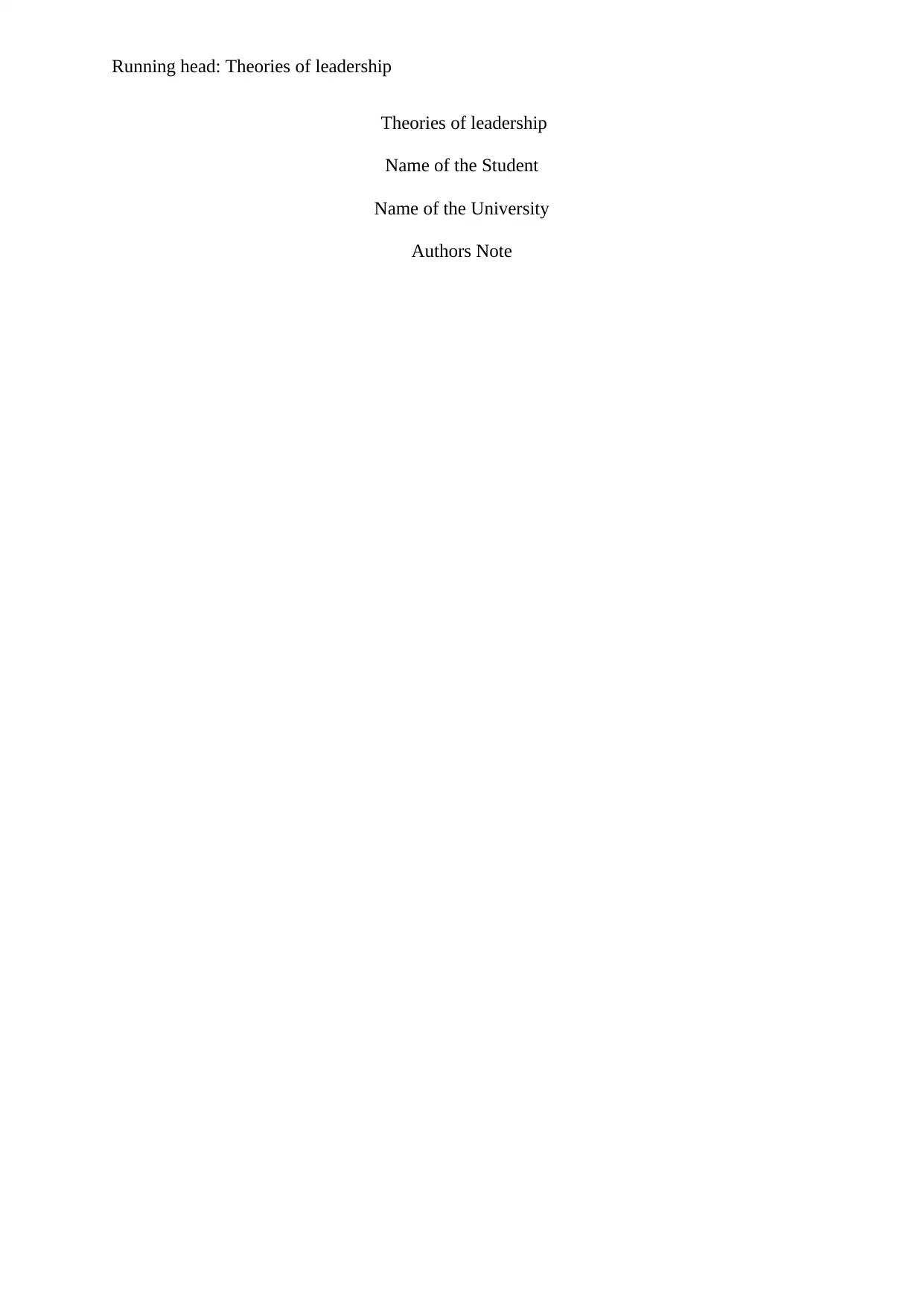
Running head: Theories of leadership
Theories of leadership
Name of the Student
Name of the University
Authors Note
Theories of leadership
Name of the Student
Name of the University
Authors Note
Paraphrase This Document
Need a fresh take? Get an instant paraphrase of this document with our AI Paraphraser
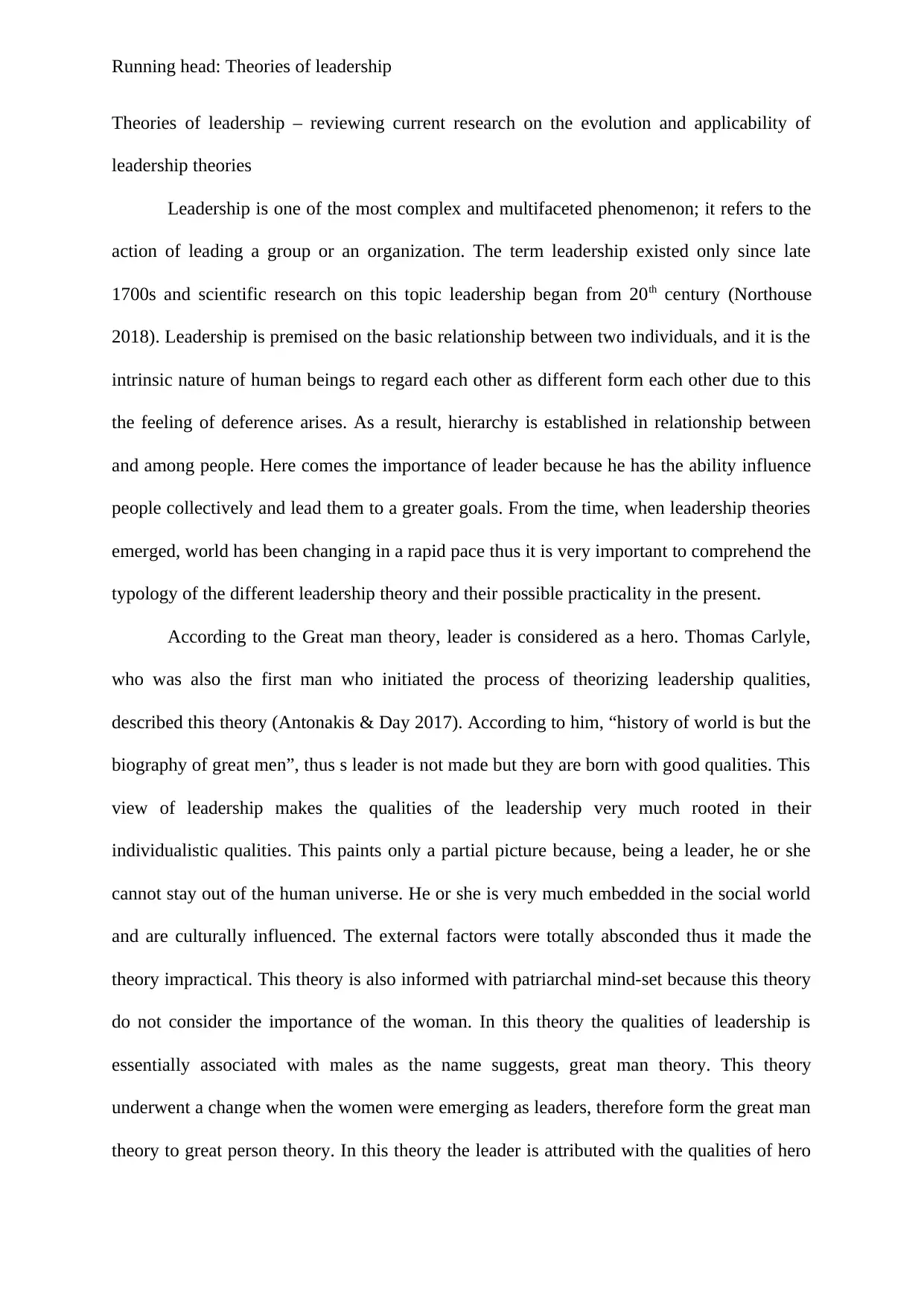
Running head: Theories of leadership
Theories of leadership – reviewing current research on the evolution and applicability of
leadership theories
Leadership is one of the most complex and multifaceted phenomenon; it refers to the
action of leading a group or an organization. The term leadership existed only since late
1700s and scientific research on this topic leadership began from 20th century (Northouse
2018). Leadership is premised on the basic relationship between two individuals, and it is the
intrinsic nature of human beings to regard each other as different form each other due to this
the feeling of deference arises. As a result, hierarchy is established in relationship between
and among people. Here comes the importance of leader because he has the ability influence
people collectively and lead them to a greater goals. From the time, when leadership theories
emerged, world has been changing in a rapid pace thus it is very important to comprehend the
typology of the different leadership theory and their possible practicality in the present.
According to the Great man theory, leader is considered as a hero. Thomas Carlyle,
who was also the first man who initiated the process of theorizing leadership qualities,
described this theory (Antonakis & Day 2017). According to him, “history of world is but the
biography of great men”, thus s leader is not made but they are born with good qualities. This
view of leadership makes the qualities of the leadership very much rooted in their
individualistic qualities. This paints only a partial picture because, being a leader, he or she
cannot stay out of the human universe. He or she is very much embedded in the social world
and are culturally influenced. The external factors were totally absconded thus it made the
theory impractical. This theory is also informed with patriarchal mind-set because this theory
do not consider the importance of the woman. In this theory the qualities of leadership is
essentially associated with males as the name suggests, great man theory. This theory
underwent a change when the women were emerging as leaders, therefore form the great man
theory to great person theory. In this theory the leader is attributed with the qualities of hero
Theories of leadership – reviewing current research on the evolution and applicability of
leadership theories
Leadership is one of the most complex and multifaceted phenomenon; it refers to the
action of leading a group or an organization. The term leadership existed only since late
1700s and scientific research on this topic leadership began from 20th century (Northouse
2018). Leadership is premised on the basic relationship between two individuals, and it is the
intrinsic nature of human beings to regard each other as different form each other due to this
the feeling of deference arises. As a result, hierarchy is established in relationship between
and among people. Here comes the importance of leader because he has the ability influence
people collectively and lead them to a greater goals. From the time, when leadership theories
emerged, world has been changing in a rapid pace thus it is very important to comprehend the
typology of the different leadership theory and their possible practicality in the present.
According to the Great man theory, leader is considered as a hero. Thomas Carlyle,
who was also the first man who initiated the process of theorizing leadership qualities,
described this theory (Antonakis & Day 2017). According to him, “history of world is but the
biography of great men”, thus s leader is not made but they are born with good qualities. This
view of leadership makes the qualities of the leadership very much rooted in their
individualistic qualities. This paints only a partial picture because, being a leader, he or she
cannot stay out of the human universe. He or she is very much embedded in the social world
and are culturally influenced. The external factors were totally absconded thus it made the
theory impractical. This theory is also informed with patriarchal mind-set because this theory
do not consider the importance of the woman. In this theory the qualities of leadership is
essentially associated with males as the name suggests, great man theory. This theory
underwent a change when the women were emerging as leaders, therefore form the great man
theory to great person theory. In this theory the leader is attributed with the qualities of hero
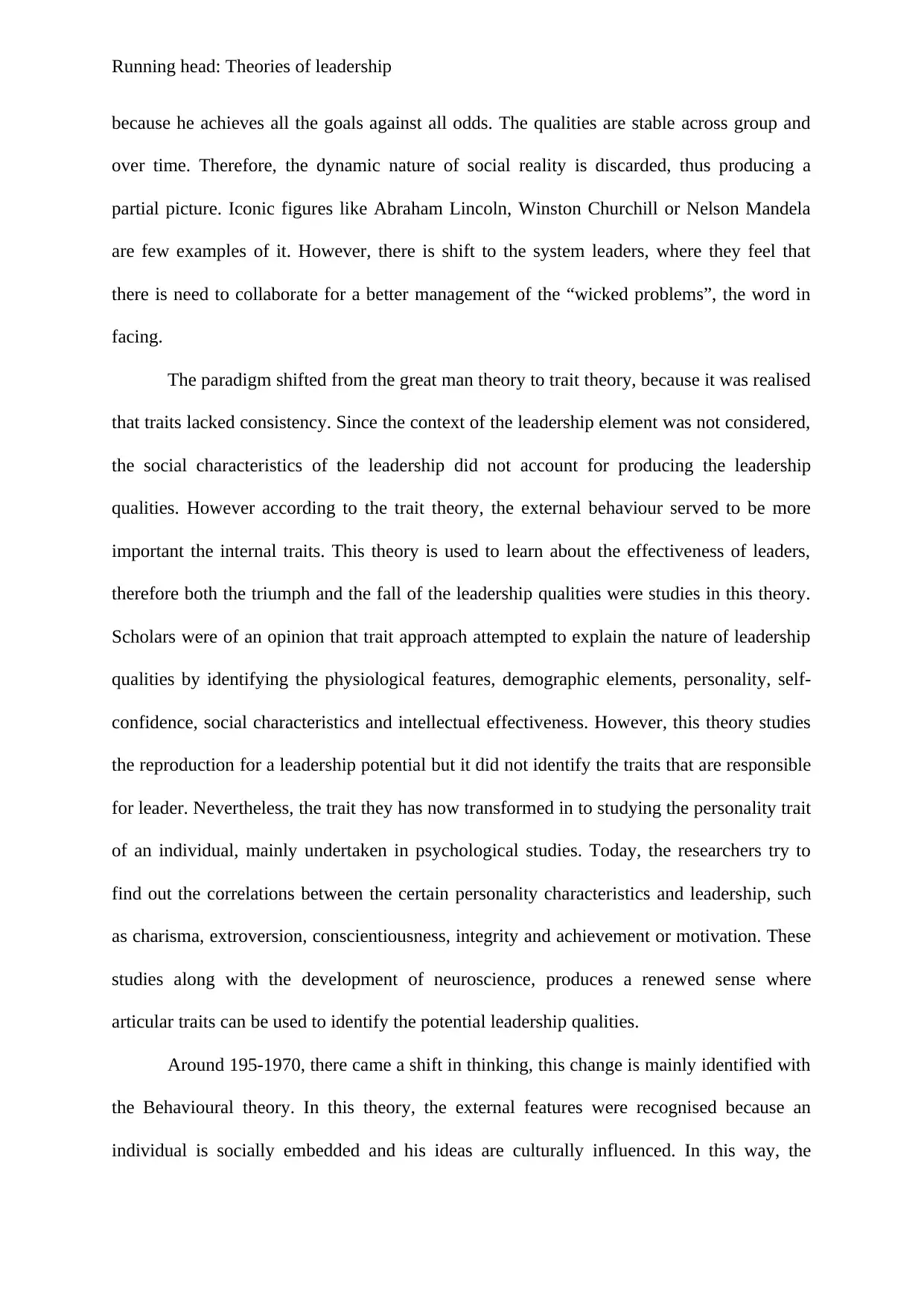
Running head: Theories of leadership
because he achieves all the goals against all odds. The qualities are stable across group and
over time. Therefore, the dynamic nature of social reality is discarded, thus producing a
partial picture. Iconic figures like Abraham Lincoln, Winston Churchill or Nelson Mandela
are few examples of it. However, there is shift to the system leaders, where they feel that
there is need to collaborate for a better management of the “wicked problems”, the word in
facing.
The paradigm shifted from the great man theory to trait theory, because it was realised
that traits lacked consistency. Since the context of the leadership element was not considered,
the social characteristics of the leadership did not account for producing the leadership
qualities. However according to the trait theory, the external behaviour served to be more
important the internal traits. This theory is used to learn about the effectiveness of leaders,
therefore both the triumph and the fall of the leadership qualities were studies in this theory.
Scholars were of an opinion that trait approach attempted to explain the nature of leadership
qualities by identifying the physiological features, demographic elements, personality, self-
confidence, social characteristics and intellectual effectiveness. However, this theory studies
the reproduction for a leadership potential but it did not identify the traits that are responsible
for leader. Nevertheless, the trait they has now transformed in to studying the personality trait
of an individual, mainly undertaken in psychological studies. Today, the researchers try to
find out the correlations between the certain personality characteristics and leadership, such
as charisma, extroversion, conscientiousness, integrity and achievement or motivation. These
studies along with the development of neuroscience, produces a renewed sense where
articular traits can be used to identify the potential leadership qualities.
Around 195-1970, there came a shift in thinking, this change is mainly identified with
the Behavioural theory. In this theory, the external features were recognised because an
individual is socially embedded and his ideas are culturally influenced. In this way, the
because he achieves all the goals against all odds. The qualities are stable across group and
over time. Therefore, the dynamic nature of social reality is discarded, thus producing a
partial picture. Iconic figures like Abraham Lincoln, Winston Churchill or Nelson Mandela
are few examples of it. However, there is shift to the system leaders, where they feel that
there is need to collaborate for a better management of the “wicked problems”, the word in
facing.
The paradigm shifted from the great man theory to trait theory, because it was realised
that traits lacked consistency. Since the context of the leadership element was not considered,
the social characteristics of the leadership did not account for producing the leadership
qualities. However according to the trait theory, the external behaviour served to be more
important the internal traits. This theory is used to learn about the effectiveness of leaders,
therefore both the triumph and the fall of the leadership qualities were studies in this theory.
Scholars were of an opinion that trait approach attempted to explain the nature of leadership
qualities by identifying the physiological features, demographic elements, personality, self-
confidence, social characteristics and intellectual effectiveness. However, this theory studies
the reproduction for a leadership potential but it did not identify the traits that are responsible
for leader. Nevertheless, the trait they has now transformed in to studying the personality trait
of an individual, mainly undertaken in psychological studies. Today, the researchers try to
find out the correlations between the certain personality characteristics and leadership, such
as charisma, extroversion, conscientiousness, integrity and achievement or motivation. These
studies along with the development of neuroscience, produces a renewed sense where
articular traits can be used to identify the potential leadership qualities.
Around 195-1970, there came a shift in thinking, this change is mainly identified with
the Behavioural theory. In this theory, the external features were recognised because an
individual is socially embedded and his ideas are culturally influenced. In this way, the
⊘ This is a preview!⊘
Do you want full access?
Subscribe today to unlock all pages.

Trusted by 1+ million students worldwide
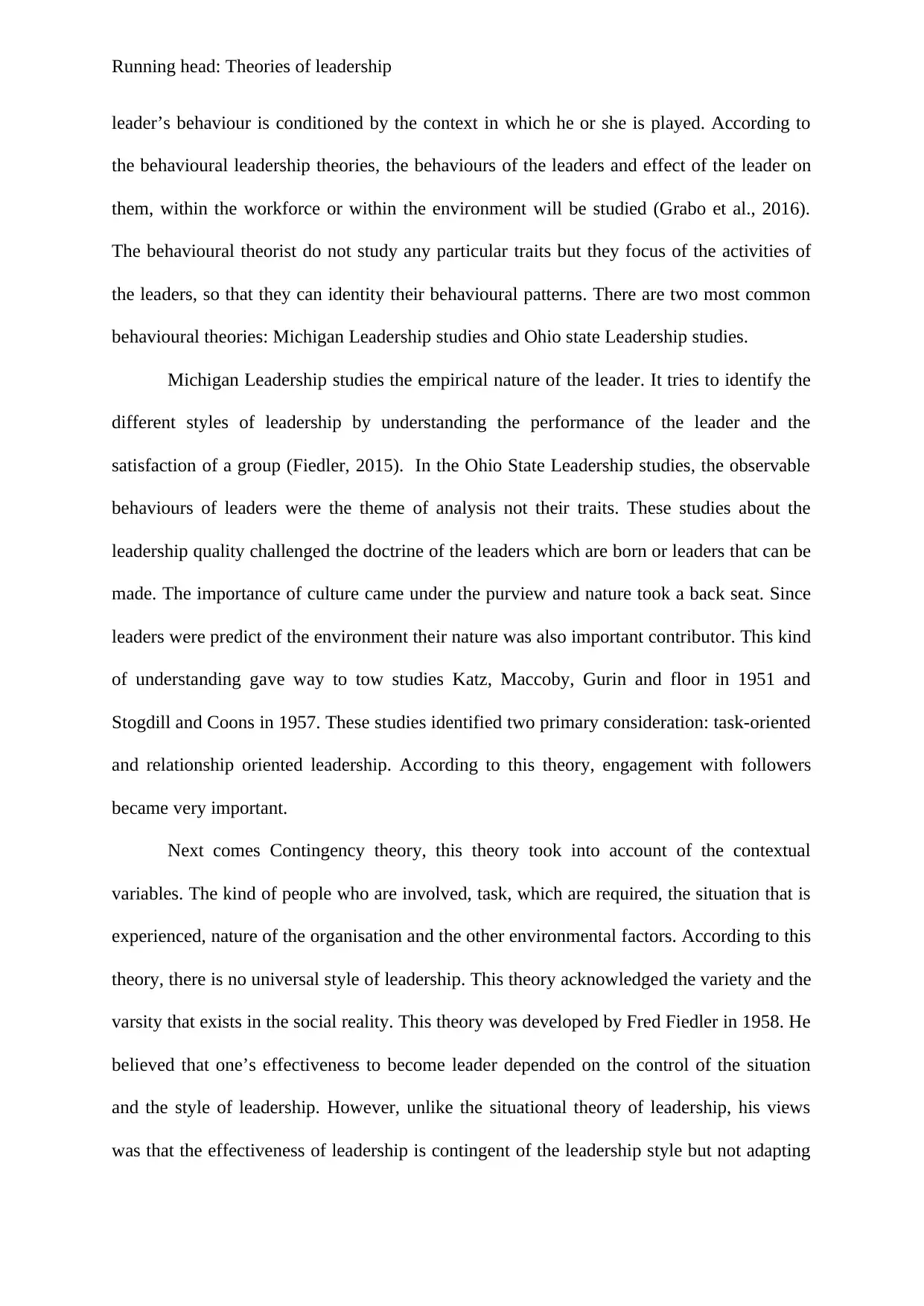
Running head: Theories of leadership
leader’s behaviour is conditioned by the context in which he or she is played. According to
the behavioural leadership theories, the behaviours of the leaders and effect of the leader on
them, within the workforce or within the environment will be studied (Grabo et al., 2016).
The behavioural theorist do not study any particular traits but they focus of the activities of
the leaders, so that they can identity their behavioural patterns. There are two most common
behavioural theories: Michigan Leadership studies and Ohio state Leadership studies.
Michigan Leadership studies the empirical nature of the leader. It tries to identify the
different styles of leadership by understanding the performance of the leader and the
satisfaction of a group (Fiedler, 2015). In the Ohio State Leadership studies, the observable
behaviours of leaders were the theme of analysis not their traits. These studies about the
leadership quality challenged the doctrine of the leaders which are born or leaders that can be
made. The importance of culture came under the purview and nature took a back seat. Since
leaders were predict of the environment their nature was also important contributor. This kind
of understanding gave way to tow studies Katz, Maccoby, Gurin and floor in 1951 and
Stogdill and Coons in 1957. These studies identified two primary consideration: task-oriented
and relationship oriented leadership. According to this theory, engagement with followers
became very important.
Next comes Contingency theory, this theory took into account of the contextual
variables. The kind of people who are involved, task, which are required, the situation that is
experienced, nature of the organisation and the other environmental factors. According to this
theory, there is no universal style of leadership. This theory acknowledged the variety and the
varsity that exists in the social reality. This theory was developed by Fred Fiedler in 1958. He
believed that one’s effectiveness to become leader depended on the control of the situation
and the style of leadership. However, unlike the situational theory of leadership, his views
was that the effectiveness of leadership is contingent of the leadership style but not adapting
leader’s behaviour is conditioned by the context in which he or she is played. According to
the behavioural leadership theories, the behaviours of the leaders and effect of the leader on
them, within the workforce or within the environment will be studied (Grabo et al., 2016).
The behavioural theorist do not study any particular traits but they focus of the activities of
the leaders, so that they can identity their behavioural patterns. There are two most common
behavioural theories: Michigan Leadership studies and Ohio state Leadership studies.
Michigan Leadership studies the empirical nature of the leader. It tries to identify the
different styles of leadership by understanding the performance of the leader and the
satisfaction of a group (Fiedler, 2015). In the Ohio State Leadership studies, the observable
behaviours of leaders were the theme of analysis not their traits. These studies about the
leadership quality challenged the doctrine of the leaders which are born or leaders that can be
made. The importance of culture came under the purview and nature took a back seat. Since
leaders were predict of the environment their nature was also important contributor. This kind
of understanding gave way to tow studies Katz, Maccoby, Gurin and floor in 1951 and
Stogdill and Coons in 1957. These studies identified two primary consideration: task-oriented
and relationship oriented leadership. According to this theory, engagement with followers
became very important.
Next comes Contingency theory, this theory took into account of the contextual
variables. The kind of people who are involved, task, which are required, the situation that is
experienced, nature of the organisation and the other environmental factors. According to this
theory, there is no universal style of leadership. This theory acknowledged the variety and the
varsity that exists in the social reality. This theory was developed by Fred Fiedler in 1958. He
believed that one’s effectiveness to become leader depended on the control of the situation
and the style of leadership. However, unlike the situational theory of leadership, his views
was that the effectiveness of leadership is contingent of the leadership style but not adapting
Paraphrase This Document
Need a fresh take? Get an instant paraphrase of this document with our AI Paraphraser
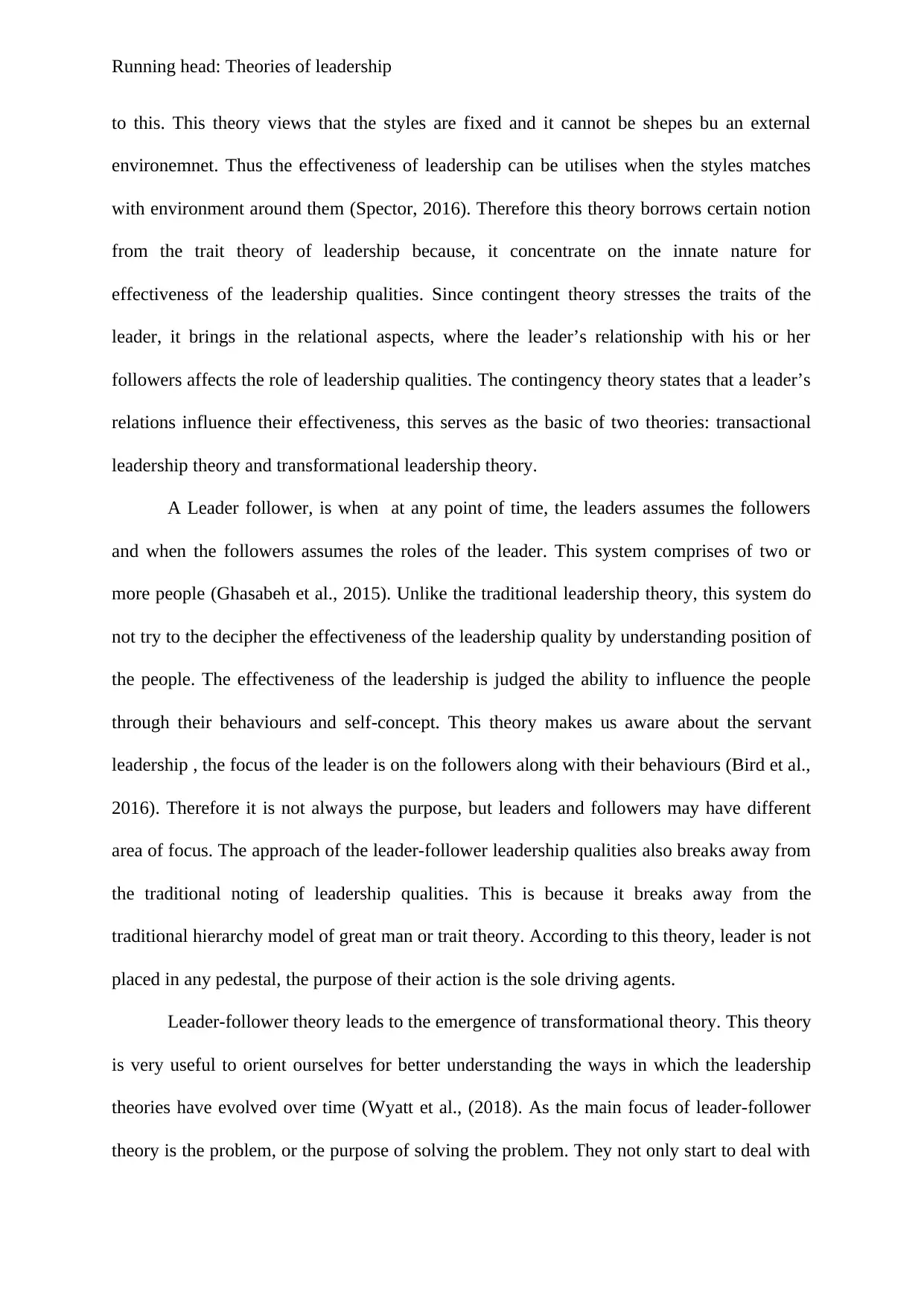
Running head: Theories of leadership
to this. This theory views that the styles are fixed and it cannot be shepes bu an external
environemnet. Thus the effectiveness of leadership can be utilises when the styles matches
with environment around them (Spector, 2016). Therefore this theory borrows certain notion
from the trait theory of leadership because, it concentrate on the innate nature for
effectiveness of the leadership qualities. Since contingent theory stresses the traits of the
leader, it brings in the relational aspects, where the leader’s relationship with his or her
followers affects the role of leadership qualities. The contingency theory states that a leader’s
relations influence their effectiveness, this serves as the basic of two theories: transactional
leadership theory and transformational leadership theory.
A Leader follower, is when at any point of time, the leaders assumes the followers
and when the followers assumes the roles of the leader. This system comprises of two or
more people (Ghasabeh et al., 2015). Unlike the traditional leadership theory, this system do
not try to the decipher the effectiveness of the leadership quality by understanding position of
the people. The effectiveness of the leadership is judged the ability to influence the people
through their behaviours and self-concept. This theory makes us aware about the servant
leadership , the focus of the leader is on the followers along with their behaviours (Bird et al.,
2016). Therefore it is not always the purpose, but leaders and followers may have different
area of focus. The approach of the leader-follower leadership qualities also breaks away from
the traditional noting of leadership qualities. This is because it breaks away from the
traditional hierarchy model of great man or trait theory. According to this theory, leader is not
placed in any pedestal, the purpose of their action is the sole driving agents.
Leader-follower theory leads to the emergence of transformational theory. This theory
is very useful to orient ourselves for better understanding the ways in which the leadership
theories have evolved over time (Wyatt et al., (2018). As the main focus of leader-follower
theory is the problem, or the purpose of solving the problem. They not only start to deal with
to this. This theory views that the styles are fixed and it cannot be shepes bu an external
environemnet. Thus the effectiveness of leadership can be utilises when the styles matches
with environment around them (Spector, 2016). Therefore this theory borrows certain notion
from the trait theory of leadership because, it concentrate on the innate nature for
effectiveness of the leadership qualities. Since contingent theory stresses the traits of the
leader, it brings in the relational aspects, where the leader’s relationship with his or her
followers affects the role of leadership qualities. The contingency theory states that a leader’s
relations influence their effectiveness, this serves as the basic of two theories: transactional
leadership theory and transformational leadership theory.
A Leader follower, is when at any point of time, the leaders assumes the followers
and when the followers assumes the roles of the leader. This system comprises of two or
more people (Ghasabeh et al., 2015). Unlike the traditional leadership theory, this system do
not try to the decipher the effectiveness of the leadership quality by understanding position of
the people. The effectiveness of the leadership is judged the ability to influence the people
through their behaviours and self-concept. This theory makes us aware about the servant
leadership , the focus of the leader is on the followers along with their behaviours (Bird et al.,
2016). Therefore it is not always the purpose, but leaders and followers may have different
area of focus. The approach of the leader-follower leadership qualities also breaks away from
the traditional noting of leadership qualities. This is because it breaks away from the
traditional hierarchy model of great man or trait theory. According to this theory, leader is not
placed in any pedestal, the purpose of their action is the sole driving agents.
Leader-follower theory leads to the emergence of transformational theory. This theory
is very useful to orient ourselves for better understanding the ways in which the leadership
theories have evolved over time (Wyatt et al., (2018). As the main focus of leader-follower
theory is the problem, or the purpose of solving the problem. They not only start to deal with
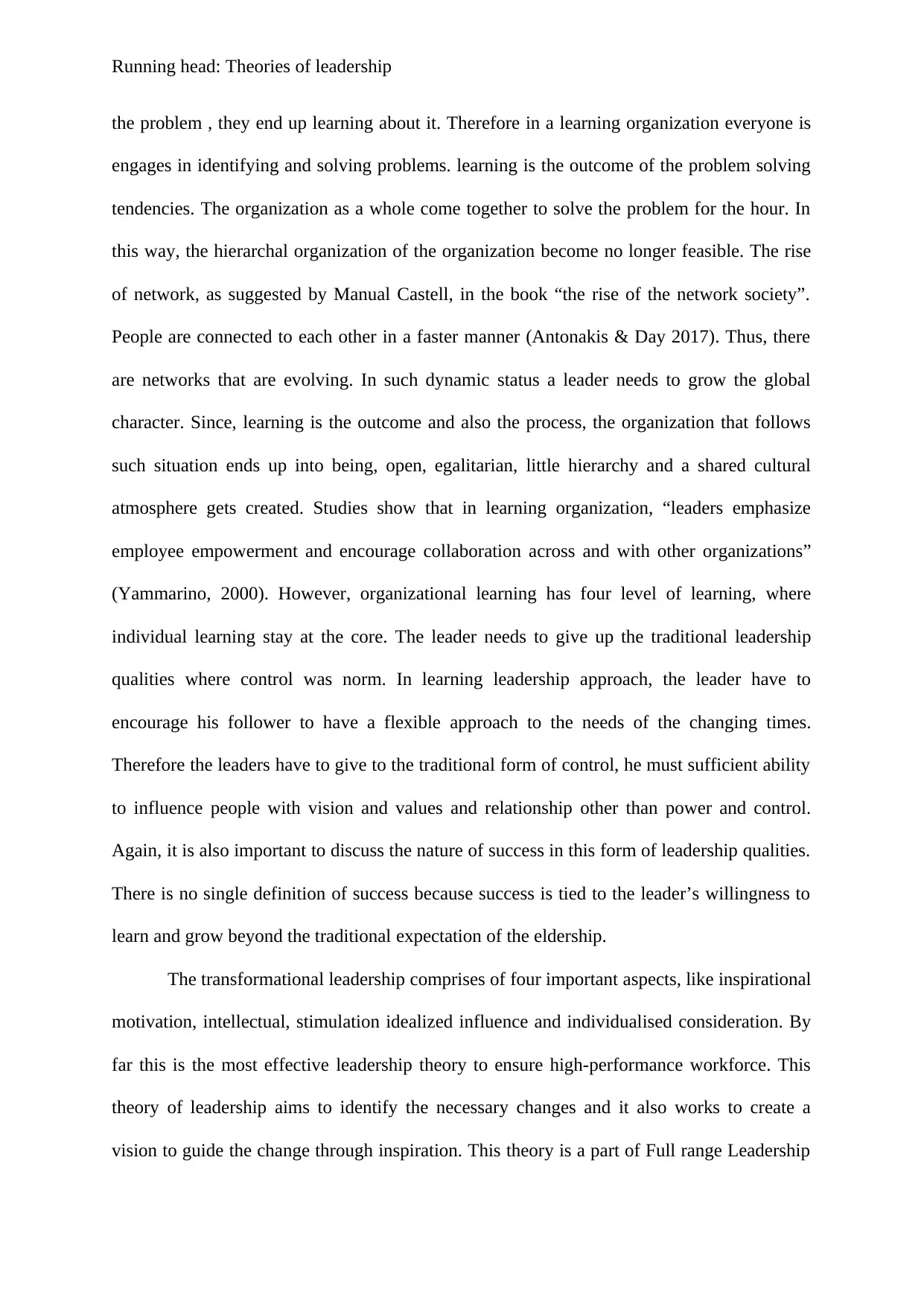
Running head: Theories of leadership
the problem , they end up learning about it. Therefore in a learning organization everyone is
engages in identifying and solving problems. learning is the outcome of the problem solving
tendencies. The organization as a whole come together to solve the problem for the hour. In
this way, the hierarchal organization of the organization become no longer feasible. The rise
of network, as suggested by Manual Castell, in the book “the rise of the network society”.
People are connected to each other in a faster manner (Antonakis & Day 2017). Thus, there
are networks that are evolving. In such dynamic status a leader needs to grow the global
character. Since, learning is the outcome and also the process, the organization that follows
such situation ends up into being, open, egalitarian, little hierarchy and a shared cultural
atmosphere gets created. Studies show that in learning organization, “leaders emphasize
employee empowerment and encourage collaboration across and with other organizations”
(Yammarino, 2000). However, organizational learning has four level of learning, where
individual learning stay at the core. The leader needs to give up the traditional leadership
qualities where control was norm. In learning leadership approach, the leader have to
encourage his follower to have a flexible approach to the needs of the changing times.
Therefore the leaders have to give to the traditional form of control, he must sufficient ability
to influence people with vision and values and relationship other than power and control.
Again, it is also important to discuss the nature of success in this form of leadership qualities.
There is no single definition of success because success is tied to the leader’s willingness to
learn and grow beyond the traditional expectation of the eldership.
The transformational leadership comprises of four important aspects, like inspirational
motivation, intellectual, stimulation idealized influence and individualised consideration. By
far this is the most effective leadership theory to ensure high-performance workforce. This
theory of leadership aims to identify the necessary changes and it also works to create a
vision to guide the change through inspiration. This theory is a part of Full range Leadership
the problem , they end up learning about it. Therefore in a learning organization everyone is
engages in identifying and solving problems. learning is the outcome of the problem solving
tendencies. The organization as a whole come together to solve the problem for the hour. In
this way, the hierarchal organization of the organization become no longer feasible. The rise
of network, as suggested by Manual Castell, in the book “the rise of the network society”.
People are connected to each other in a faster manner (Antonakis & Day 2017). Thus, there
are networks that are evolving. In such dynamic status a leader needs to grow the global
character. Since, learning is the outcome and also the process, the organization that follows
such situation ends up into being, open, egalitarian, little hierarchy and a shared cultural
atmosphere gets created. Studies show that in learning organization, “leaders emphasize
employee empowerment and encourage collaboration across and with other organizations”
(Yammarino, 2000). However, organizational learning has four level of learning, where
individual learning stay at the core. The leader needs to give up the traditional leadership
qualities where control was norm. In learning leadership approach, the leader have to
encourage his follower to have a flexible approach to the needs of the changing times.
Therefore the leaders have to give to the traditional form of control, he must sufficient ability
to influence people with vision and values and relationship other than power and control.
Again, it is also important to discuss the nature of success in this form of leadership qualities.
There is no single definition of success because success is tied to the leader’s willingness to
learn and grow beyond the traditional expectation of the eldership.
The transformational leadership comprises of four important aspects, like inspirational
motivation, intellectual, stimulation idealized influence and individualised consideration. By
far this is the most effective leadership theory to ensure high-performance workforce. This
theory of leadership aims to identify the necessary changes and it also works to create a
vision to guide the change through inspiration. This theory is a part of Full range Leadership
⊘ This is a preview!⊘
Do you want full access?
Subscribe today to unlock all pages.

Trusted by 1+ million students worldwide
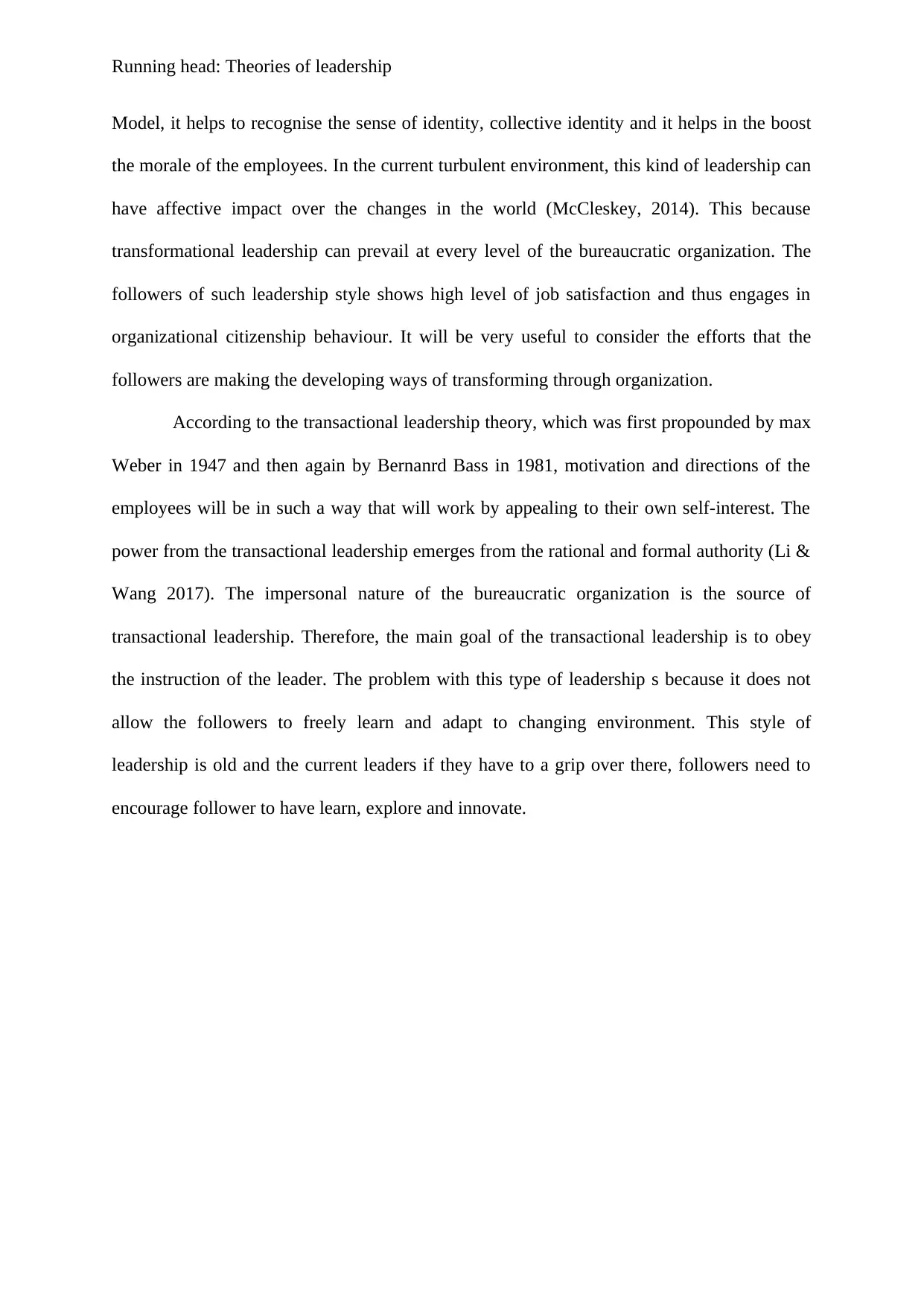
Running head: Theories of leadership
Model, it helps to recognise the sense of identity, collective identity and it helps in the boost
the morale of the employees. In the current turbulent environment, this kind of leadership can
have affective impact over the changes in the world (McCleskey, 2014). This because
transformational leadership can prevail at every level of the bureaucratic organization. The
followers of such leadership style shows high level of job satisfaction and thus engages in
organizational citizenship behaviour. It will be very useful to consider the efforts that the
followers are making the developing ways of transforming through organization.
According to the transactional leadership theory, which was first propounded by max
Weber in 1947 and then again by Bernanrd Bass in 1981, motivation and directions of the
employees will be in such a way that will work by appealing to their own self-interest. The
power from the transactional leadership emerges from the rational and formal authority (Li &
Wang 2017). The impersonal nature of the bureaucratic organization is the source of
transactional leadership. Therefore, the main goal of the transactional leadership is to obey
the instruction of the leader. The problem with this type of leadership s because it does not
allow the followers to freely learn and adapt to changing environment. This style of
leadership is old and the current leaders if they have to a grip over there, followers need to
encourage follower to have learn, explore and innovate.
Model, it helps to recognise the sense of identity, collective identity and it helps in the boost
the morale of the employees. In the current turbulent environment, this kind of leadership can
have affective impact over the changes in the world (McCleskey, 2014). This because
transformational leadership can prevail at every level of the bureaucratic organization. The
followers of such leadership style shows high level of job satisfaction and thus engages in
organizational citizenship behaviour. It will be very useful to consider the efforts that the
followers are making the developing ways of transforming through organization.
According to the transactional leadership theory, which was first propounded by max
Weber in 1947 and then again by Bernanrd Bass in 1981, motivation and directions of the
employees will be in such a way that will work by appealing to their own self-interest. The
power from the transactional leadership emerges from the rational and formal authority (Li &
Wang 2017). The impersonal nature of the bureaucratic organization is the source of
transactional leadership. Therefore, the main goal of the transactional leadership is to obey
the instruction of the leader. The problem with this type of leadership s because it does not
allow the followers to freely learn and adapt to changing environment. This style of
leadership is old and the current leaders if they have to a grip over there, followers need to
encourage follower to have learn, explore and innovate.
Paraphrase This Document
Need a fresh take? Get an instant paraphrase of this document with our AI Paraphraser
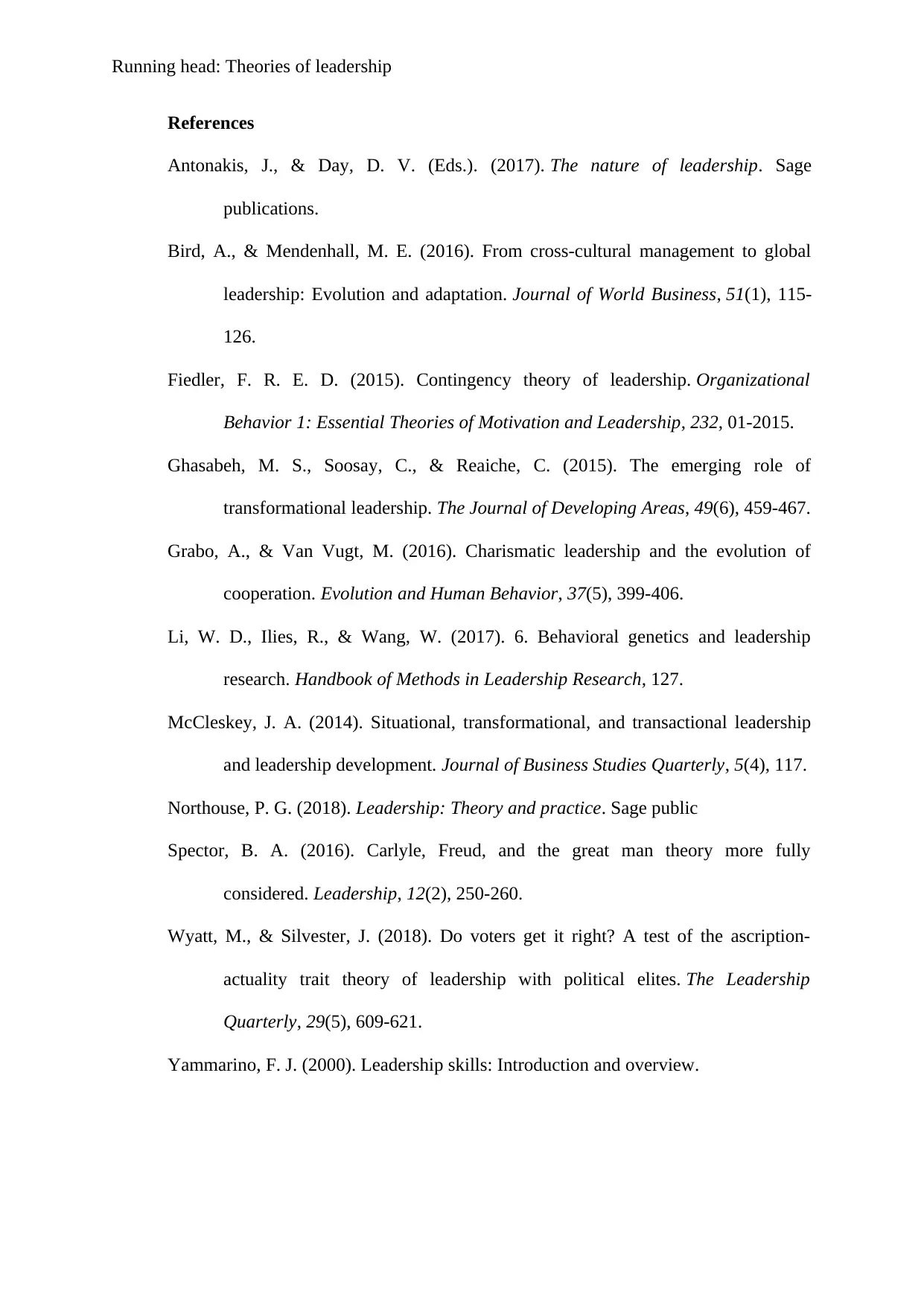
Running head: Theories of leadership
References
Antonakis, J., & Day, D. V. (Eds.). (2017). The nature of leadership. Sage
publications.
Bird, A., & Mendenhall, M. E. (2016). From cross-cultural management to global
leadership: Evolution and adaptation. Journal of World Business, 51(1), 115-
126.
Fiedler, F. R. E. D. (2015). Contingency theory of leadership. Organizational
Behavior 1: Essential Theories of Motivation and Leadership, 232, 01-2015.
Ghasabeh, M. S., Soosay, C., & Reaiche, C. (2015). The emerging role of
transformational leadership. The Journal of Developing Areas, 49(6), 459-467.
Grabo, A., & Van Vugt, M. (2016). Charismatic leadership and the evolution of
cooperation. Evolution and Human Behavior, 37(5), 399-406.
Li, W. D., Ilies, R., & Wang, W. (2017). 6. Behavioral genetics and leadership
research. Handbook of Methods in Leadership Research, 127.
McCleskey, J. A. (2014). Situational, transformational, and transactional leadership
and leadership development. Journal of Business Studies Quarterly, 5(4), 117.
Northouse, P. G. (2018). Leadership: Theory and practice. Sage public
Spector, B. A. (2016). Carlyle, Freud, and the great man theory more fully
considered. Leadership, 12(2), 250-260.
Wyatt, M., & Silvester, J. (2018). Do voters get it right? A test of the ascription-
actuality trait theory of leadership with political elites. The Leadership
Quarterly, 29(5), 609-621.
Yammarino, F. J. (2000). Leadership skills: Introduction and overview.
References
Antonakis, J., & Day, D. V. (Eds.). (2017). The nature of leadership. Sage
publications.
Bird, A., & Mendenhall, M. E. (2016). From cross-cultural management to global
leadership: Evolution and adaptation. Journal of World Business, 51(1), 115-
126.
Fiedler, F. R. E. D. (2015). Contingency theory of leadership. Organizational
Behavior 1: Essential Theories of Motivation and Leadership, 232, 01-2015.
Ghasabeh, M. S., Soosay, C., & Reaiche, C. (2015). The emerging role of
transformational leadership. The Journal of Developing Areas, 49(6), 459-467.
Grabo, A., & Van Vugt, M. (2016). Charismatic leadership and the evolution of
cooperation. Evolution and Human Behavior, 37(5), 399-406.
Li, W. D., Ilies, R., & Wang, W. (2017). 6. Behavioral genetics and leadership
research. Handbook of Methods in Leadership Research, 127.
McCleskey, J. A. (2014). Situational, transformational, and transactional leadership
and leadership development. Journal of Business Studies Quarterly, 5(4), 117.
Northouse, P. G. (2018). Leadership: Theory and practice. Sage public
Spector, B. A. (2016). Carlyle, Freud, and the great man theory more fully
considered. Leadership, 12(2), 250-260.
Wyatt, M., & Silvester, J. (2018). Do voters get it right? A test of the ascription-
actuality trait theory of leadership with political elites. The Leadership
Quarterly, 29(5), 609-621.
Yammarino, F. J. (2000). Leadership skills: Introduction and overview.
1 out of 8
Related Documents
Your All-in-One AI-Powered Toolkit for Academic Success.
+13062052269
info@desklib.com
Available 24*7 on WhatsApp / Email
![[object Object]](/_next/static/media/star-bottom.7253800d.svg)
Unlock your academic potential
Copyright © 2020–2025 A2Z Services. All Rights Reserved. Developed and managed by ZUCOL.




